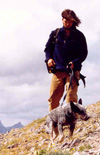 |
Prof. Hall collects a rhododendron leaf for his lab. Last year he and his wife established a new fellowship for international students at the Department of Biology Graduate Program. |
As I sat next to legendary professor Ben Hall on the drive out to the Rhododendron Species Botanical Garden to pick up some samples for his research, I asked how he and a postdoc made a discovery that changed his life and the lives of many others — resulting in the creation of a vaccine for Hepatitis B virus. The story begins when the science of genetic engineering was in its infancy.
Ben Hall joined the Genetics faculty at the UW in 1963. Department Chair Herschel Roman introduced him to hybrid rhododendrons, but Hall didn’t develop an interest in species Rhododendrons until the early 90s. During the intervening years, Hall was fully occupied by trying to understand transcription, the process by which genes (DNA) make their working copies (RNA). As an experimental system to study this process, his lab used baker’s yeast (Saccharomyces), an organism made tractable for genetic studies by Professor Roman.
Basic research on yeast transcription and applications to medicine and human health unexpectedly crossed paths in 1980-81. Dr. Gustav Ammerer, a postdoctoral fellow in Hall’s lab, was using the newly available methods of gene splicing — very primitive ones, by today’s standards — to locate the part of a gene essential for its transcription (the promoter). When he succeeded, by exchanging parts between two yeast genes, it occurred to Ammerer and Hall that the promoter could also be spliced to a gene coming from another organism, for example a human gene. If this hybrid gene proved to be active in a yeast cell, a general method of making heterologous (non-yeast) proteins in yeast would result. This did indeed happen and the practical consequences were quickly perceived. The UW and Genentech jointly filed a patent application for protein expression in yeast in 1981 and the patent was issued in 1996.
When genetic engineering was first applied to problems in human health, a vaccine against Human Hepatitis B Virus (Hep B) was high on the wish list. Hep B is transmitted sexually and by intravenous drug use, as well as from mother to child. Viral DNA had been isolated and sequenced and the viral coat protein was known to confer immunity, suggesting a route to the vaccine. Many labs tried unsuccessfully to use the popular E.coli system to produce the vaccine. The viral genes caused the bacteria to grow slowly, and the bacteria degraded the viral protein. Then along came Ammerer and Hall with their new yeast expression system.
Several research groups working on Hep B wanted to avail themselves of the yeast technology. The UW researchers chose to enter into a collaboration with UCSF scientists Rutter and Valenzuela, who had access to Hep B viral DNA. Merck & Co. gave financial support to the project. Within two months, the experiments were successful; Hep B coat protein was being made in yeast, where it serendipitously formed clusters of molecules resembling the virus core. By forming these particles, “it made for a far more effective immunogen – more immunity with less dose,” said Hall. In the summer of 1981, the UW and UC jointly filed a patent application for Hepatitis B surface antigen expression. Vaccine made by this process is now routinely given to newborn babies in many countries, including the US, Europe and China.
These patents have since yielded income that has benefited all parties involved. Because of the royalties, Hall no longer has to write grant applications for research funding. “If you can imagine how glorious that feeling is!” said Hall. “What I wanted to study was Rhododendrons. I developed an interest in using gene sequences for finding out about evolution in organisms including fungi and plants.”
Hall has chosen to help others with the income generated from the patent, and continues to donate to many worthy causes each year. He and his wife, Margaret, recently created a new graduate fellowship for international students in the Department of Biology. This is reminiscent of his collaboration with Gustav Ammerer, who received support from an Austrian non-profit foundation, the Max Kade foundation, during his stay in Seattle.
Article and photo by Liorah Wichser



 Together this dog and his trainer, Heath Smith, search for sign from grizzlies in Alberta, Canada. They are part of a novel and non-invasive animal tracking program started at the Center for Conservation Biology. This program is one of several at the department that conducts research to help save the lives of endangered species.
Every bit counts. Your choice to support the Department of Biology could make a big difference in how our future turns out.
Together this dog and his trainer, Heath Smith, search for sign from grizzlies in Alberta, Canada. They are part of a novel and non-invasive animal tracking program started at the Center for Conservation Biology. This program is one of several at the department that conducts research to help save the lives of endangered species.
Every bit counts. Your choice to support the Department of Biology could make a big difference in how our future turns out.